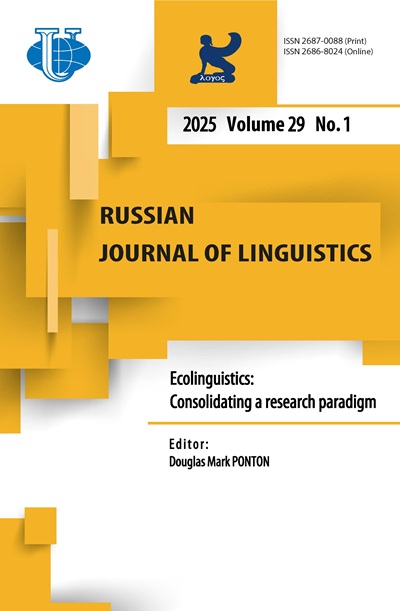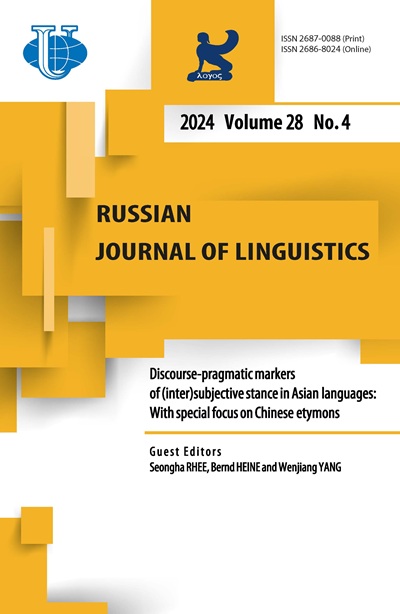От объективных функций к субъективным и интерсубъективным: тайская лексема ciŋ «истина»
- Авторы: Кхамми К.1
-
Учреждения:
- Университет Пхаяо
- Выпуск: Том 28, № 4 (2024): Discourse-pragmatic markers of (inter)subjective stance in Asian languages: With special focus on Chinese etymons
- Страницы: 942-965
- Раздел: Статьи
- URL: https://journals.rudn.ru/linguistics/article/view/42181
- DOI: https://doi.org/10.22363/2687-0088-40496
- EDN: https://elibrary.ru/LMSZDN
Цитировать
Полный текст
Аннотация
Заимствованные лексемы, развивающиеся в дискурсивные маркеры (ДМ), являются уникальными лингвистическими феноменами с точки зрения контактной лингвистики и грамматикализации. Несмотря на то, что сино-тайские лексемы достаточно многочисленны и частотны, до сих пор не было серьезных попыток их проанализировать. Целью данного исследования является выявление и описание различных дискурсивных функций сино-тайских лексем, в том числе лексемы ciŋ «истинный», с опорой на корпусные данные. Среди наших задач - анализ их развития с точки зрения механизмов грамматикализации, выявление их свойств в качестве ДМ, сравнение с развитием, описанным в других языках, и построение концептуально-функциональной сетки. Данные, полученные из различных источников, включая исторические и современные словари, онлайн-ресурсы, справочные грамматики, современные корпуса и т.д., показывают, что лексема ciŋ «истинный» обозначает «истинный, истина, реальный» (объективное значение), но при адвербиальном употреблении в качестве усилителя она обозначает «конечно, определенно» (субъективное значение), что является естественным развитием ее лексического значения. В сфере дискурса лексема выполняет ряд интеракциональных функций (интерсубъективное значение). Рассмотрение тайских ДМ на основе ciŋ «истинный» («истина - ДМ») в свете параметров грамматикализации показывает, что изменения, характеризуемые как десемантизация, расширение значения и декатегоризация, лежат на поверхности, их можно наблюдать, тогда как эрозия носит скрытый характер, либо не наблюдается. Несмотря на различную степень десемантизации, семантическое изменение в направлении от объективного значения - к субъективному и далее - к интерсубъективному является значительным. Несмотря на функциональное сходство «истина - ДМ» в разных языках, различия между ними весьма значимы. Полученные результаты способствуют пониманию роли исходной семантики, а также ее ограничений в процессе развития дискурсивных маркеров.
Ключевые слова
Об авторах
Культида Кхамми
Университет Пхаяо
Автор, ответственный за переписку.
Email: annenfants@gmail.com
ORCID iD: 0000-0002-5620-7487
получила PhD по прикладной лингвистике в Университете Махидол, Таиланд, преподает в Университете Пхаяо, Таиланд, с 2012 г. Ее научные интересы включают анализ текста, когнитивную лингвистику, культурологию, а также изменение языка с кросс-лингвистической и типологической точек зрения. Она является автором и соавтором ряда статей, опубликованных в Journal of Pragmatics, GEMA Online® Journal of Language Studies, World Journal of English Language и др., а также глав книги Culture-Bound Syndromes in Popular Culture (2024, Routledge).
Пхаяо, ТаиландСписок литературы
- Aijmer, Karin. 1986. Why is actually so popular in spoken English? In Gunnel Tottie & Ingegerd Bäcklund (eds.), English in speech and writing: A symposium, 119-129. Uppsala: Almqvist & Wilsell International.
- Aijmer, Karin. 2016. Revisiting actually in different positions in some national varieties of English. In Francisco Alonso Almeida, Laura Cruz Garcia & Victor M. Gonzales Ruiz (eds.), Corpus-based studies on language varieties, 115-143. Bristol: Peter Lang.
- Aijmer, Karin, Ad Foolen & Anne-Marie Simon-Vandenbergen. 2006. Pragmatic markers in translation: A methodological proposal. In Kerstin Fischer (ed.), Approaches to discourse particles, 101-114. Amsterdam: Elsevier.
- Betz, Emma. 2015. Indexing epistemic access through different confirmation formats: Uses of responsive (das) stimmt in German interaction. Journal of Pragmatics 87. 251-266.
- Blanco-Suárez, Zeltia. 2014. The competition between the intensifiers dead and deadly. In Hilde Hasselgård, Jarle Ebeling & Signe Oksefjell Ebeling (eds.), Corpus perspectives on patterns of lexis, 71-90. Amsterdam: John Benjamins.
- Bolden, Galina B., Alexa Hepburn & Jenny Mandelbaum. 2023. The distinctive uses of right in British and American English interaction. Journal of Pragmatics 205. 78-91.
- Brinton, Laurel J. 2017. The Evolution of Pragmatic Markers in English: Pathways of Change. Cambridge: Cambridge University Press.
- Defour, Tine, Ulrique D’Hondt, Anne-Marie Simon-Vandenbergen & Dominique Willems. 2010. In fact, en fait, de fait, au fait: A contrastive study of the synchronic correspondences and diachronic development of English and French cognates. Neuphilologische Mitteilungen 111 (4). 433-463.
- Du Bois, John W., Susanna Cumming, Stephan Schuetze-Coburn & Danae Paolino (eds.). 1992. Discourse Transcription (Santa Barbara Papers in Linguistics 4). Department of Linguistics, University of California, Santa Barbara, Santa Barbara.
- Garcés, María Pilar Gómez. 2014. Gramaticalización y tradiciones discursivas: El proceso de creación de los marcadores de confirmación. Revue Romane 29 (2). 264-292.
- Gardner, Rod. 2001. When Listeners Talk: Response Tokens and Listener Stance. Amsterdam: John Benjamins.
- Givón, Talmy. 1971. Historical syntax and synchronic morphology: An archaeologist’s field trip. Chicago Linguistic Society 7. 394-415.
- Givón, Talmy. 2015. The Diachrony of Grammar. Amsterdam: John Benjamins.
- Gray, Mark. 2012. On the interchangeability of actually and really in spoken English: Quantitative and qualitative evidence from corpora. English Language and Linguistics 16 (1). 151-170.
- Haarmann, Harald. 2012[1986]. Language in Ethnicity: A View of Basic Ecological Relations. Berlin: Mouton.
- Haselow, Alexander. 2013. Arguing for a wide conception of grammar: The case of final particles in spoken discourse. Folia Linguistica 47 (2). 375-424.
- Heine, Bernd. 1992. Grammaticalization chains. Studies in Language 16 (2). 335-368.
- Heine, Bernd. 2013. On discourse markers: Grammaticalization, pragmaticalization, or something else? Linguistics 51 (6). 1205-1247.
- Heine, Bernd, Ulrike Claudi & Friederike Hünnemeyer. 1991. Grammaticalization: A Conceptual Framework. Chicago: The University of Chicago Press.
- Heine, Bernd, Gunther Kaltenböck, Tania Kuteva & Haiping Long. 2021. The Rise of Discourse Markers. Cambridge: Cambridge University Press.
- Heine, Bernd & Tania Kuteva. 2005. Language Contact and Grammatical Change. Cambridge: Cambridge University Press.
- Heine, Bernd & Tania Kuteva. 2007. The Genesis of Grammar: A Reconstruction. Oxford: Oxford University Press.
- Heritage, John. 1998. Oh-prefaced response to inquiry. Language in Society 27. 291-334.
- Higashiizumi, Yuko, Reijirou Shibasaki & Keiko Takahashi. 2024. From truth to truly: The case of shinni ‘truly’ in Japanese. Russian Journal of Linguistics 28 (4). 843-864. https://doi.org/10.22363/2687-0088-40518
- Hopper, Paul J. 1991. On some principles of grammaticalization. In Elizabeth C. Traugott & Bernd Heine (eds.), Approaches to grammaticalization, 2 vols. Vol. 1, 17-35. Amsterdam: John Benjamins.
- Hopper, Paul J. & Elizabeth C. Traugott. 2003. Grammaticalization. Cambridge: Cambridge University Press.
- Jucker, Andreas H. 2002. Discourse markers in Early Modern English. In Richard Watts & Peter Trudgill (eds.), Alternative histories of English, 210-230. London: Routledge.
- Khammee, Kultida & Seongha Rhee. 2022. Same and different ways of seeing faces: The cases of Korean and Thai. The Journal of Linguistic Science 103. 361-381.
- Khammee, Kultida & Seongha Rhee. 2024. Cultural meanings of ‘small’: Similar yet different semantic networks of diminutives in Thai and Korean. Selected Conference Proceedings Papers of the SOAS GLOCAL 2022 Conference in Asia. 188-200.
- Kim, Hi-Jean. 2003. The-Fact-Is-That and related constructions: A usage-based approach and implications in English education. Doctoral dissertation, Hankuk University of Foreign Studies, Seoul.
- Kuteva, Tania, Bernd Heine, Bo Hong, Haiping Long, Heiko Narrog & Seongha Rhee. 2019. World Lexicon of Grammaticalization (2nd ed.). Cambridge: Cambridge University Press.
- Kuryłowicz, Jerzy. 1975[1965]. The evolution of grammatical categories. In Eugenio Coseriu (ed.), Esquisses linguistiques II, 38-54. Munich: Fink.
- Labov, William. 1994. Principles of Linguistic Change. Volume 1: Internal Factors. Oxford: Blackwell.
- Lehmann, Christian. 2015[1982]. Thoughts on Grammaticalization (3rd ed.). Berlin: Language Science Press.
- Maschler, Yael & Roi Estlein. 2008. Stance-taking in Hebrew casual conversation via beˈemet (‘really, actually, indeed’, lit. ‘in truth’). Discourse Studies 10 (4). 283-316.
- Maschler, Yael & Carmit Miller Shaprio. 2016. The role of prosody in the grammaticization of Hebrew naxon (‘right/true’): Synchronic and diachronic aspects. Journal of Pragmatics 92. 43-73.
- Meillet, Antoine. 1912. L'évolution des formes grammaticales. Scientia 12. (Reprinted in Meillet. 1948. Linguistique Historique et Linguistique Générale 1. 130-148. Paris: Edouard Champion).
- Méndez-Naya, Belén. 2006. Adjunct, modifier, discourse marker: On the various functions of right in the history of English. Folia Linguistica Historica 40. 141-169.
- Narrog, Heiko. 2010. A diachronic dimension in maps of case functions. Linguistic Discovery 8 (1). 233-254.
- Narrog, Heiko & Shinya Ito. 2007. Re-constructing semantic maps: The comitative-instrumental area. Sprachtypolgie und Universalienforschung (STUF) 60 (4). 273-292.
- Rhee, Seongha. 2016. On the emergence of the stance-marking function of English adverbs: A case of intensifiers. Linguistic Research 33 (3). 395-436.
- Rhee, Seongha. 2021. On grammaticalization of truthfulness-based emphatic discourse markers. In Fuxiang Wu, Yonglong Yang & Haiping Long (eds.), Grammaticalization and studies of grammar 10, 461-499. Beijing: Commercial Press.
- Rhee, Seongha. 2022. Where to go at the end: Polylexicalization and polygrammaticalization of Kaz ‘edge’ in Korean. Russian Journal of Linguistics 26 (3). 571-595. https://doi.org/10.22363/2687-0088-30616
- Rhee, Seongha & Kultida Khammee. 2024. Grammaticalization of future-time reference markers in Korean and Thai. GEMA: Journal of Language Studies 24 (3). 1-19.
- Rhee, Seongha & Lin Zhang. 2024. The way of the truth: The case of Korean DM cincca in comparison with Chinese DMs zhenshi and zhende. Russian Journal of Linguistics 28 (4). 818-842. https://doi.org/10.22363/2687-0088-40500
- Ricca, Davide & Jacqueline Visconti. 2014. On the development of the Italian truth adverbs davvero and veramente. In Irma Taavitsainen, Andreas H. Jucker & Jukka Tuominen (eds.), Diachronic corpus pragmatics, 133-154. Amsterdam: John Benjamins.
- Rodríguez Somolinos, Amalia. 2011. Assertion de la vérité et engagement du locuteur: L’évolution de voirement et de vraiment en français (XIIe-XVIIe siècle). Langages 184. 91-110.
- Romaine, Suzanne. 1982. Socio-Historical Linguistics: Its Status and Methodology. Cambridge: Cambridge University Press.
- Schegloff, Emanuel A. 1996. Confirming allusions: Toward an empirical account of action. The American Journal of Sociology 102 (1). 161-216.
- Shibasaki, Reijirou & Yuko Higashiizumi. Forthcoming. An introduction. In Yuko Higashiizumi & Reijirou Shibasaki (eds.), The emergence of pragmatic markers in East Asian languages (Studies in pragmatics). Leiden: Brill.
- Simon-Vandenbergen, Anne-Marie & Dominique Willems. 2011. Crosslinguistic data as evidence in the grammaticalization debate: The case of discourse markers. Linguistics 41. 1123-1161.
- Suthiwan, Titima & Uri Tadmor. 2009. Loanwords in Thai. In Martin Haspelmath & Uri Tadmor (eds.), Loanwords in the World’s languages - a comparative handbook, 599-616. Berlin: De Gruyter Mouton.
- Traugott, Elizabeth C. 2010. (Inter)subjectivity and (inter)subjectification: A reassessment. In Kristin Davidse, Lieven Vandelanotte & Hubert Cuyckens (eds.), Subjectification, intersubjectification and grammaticalization, 29-71. Berlin: De Gruyter Mouton.
- Traugott, Elizabeth Closs & Richard B. Dasher. 2002. Regularity in Semantic Change. Cambridge: Cambridge University Press.
- Yaguchi, Michiko, Yoko Iyeiri & Yasumasa Baba. 2010. Speech style and gender distinctions in the use of very and real/really: An analysis of the corpus of spoken professional American English. Journal of Pragmatics 42. 585-597.


















